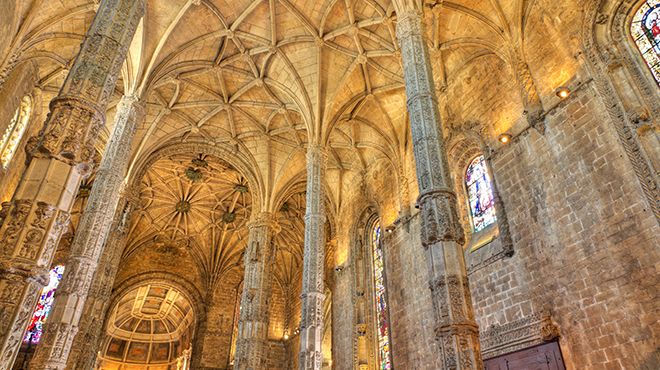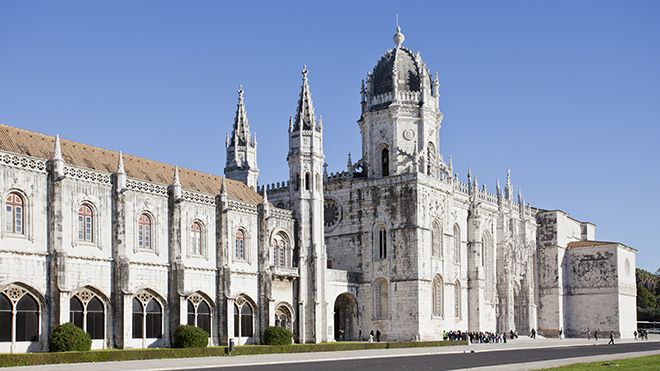Mosteiro dos Jerónimos

Monuments
On the banks of the Tagus is an apogee of Manueline architecture.
In the spot where the Jerónimos Monastery stands today, next to the old Belém beach, was originally a small hermitage dedicated to Santa Maria that had been built by the Infante D. Henrique, in 1452. At the start of the 16th century King Manuel I’s intention to have a large monastery erected there was acknowledged by the Holy See, and which was donated to the Order of the Friars of St. Jerome. The epitome of Manueline architecture and intrinsically linked to the Discoveries, this monastery is the most remarkable Portuguese monastic ensemble of its time and one of the main European churches.
Construction on it began in 1501, lasted for a hundred years and was spearheaded by a remarkable group of architects and master builders both national and foreign. With an initial design by Frenchman Boytac, the work was continued by other Masters, namely João de Castilho and, in the middle of the century, Diogo de Torralva. After the arrival of the Portuguese in India, the Portuguese crown was able to fund the venture with money coming from trade with the East. King D. Manuel I channelled much of the so-called "Vintena da Pimenta" (a ‘Spice Tax’, approximately 5% of revenues from trade with Africa and the East, equivalent to 70kg of gold per year) to finance construction work.
In this monument, classified by UNESCO as a World Heritage Site, it is worth noting the facades, the church and the cloisters. On the south facade, one can admire the portal painted by João de Castilho, where the figures are arranged according to a specific hierarchy: below, Infante D. Henrique guards the entrance, the Virgin of Bethlehem blesses the monument, and Archangel Saint Gabriel, the protector of Portugal, completes the arc. The western portal, through which one enters the sacred space, is the authorship of Nicolau Chanterenne. To the left, protected by St. Jerome, is the statue of King D. Manuel, which is said to be a realistic portrait, and to the right is that of Queen D. Maria, his wife, protected by St. John the Baptist.
Inside there is the church-hall, a Manueline masterpiece by João de Castilho. Note how, in a remarkable architectural achievement, the beautiful vault of the transept is not supported by any columns. At the entrance, after the lower-choir, are the cenotaphs of the poet Luís de Camões, author of the epic poem "Os Lusíadas", and of Vasco da Gama, commander of the armada that in 1497 went to India. The kings, princes and descendants of D. Manuel I are buried in the side chapels. In the main chapel, later reconstructed by Jerónimo de Ruão, are the tombs of D. Manuel I, his son D. João III and their wives. Worthy of special mention is the solid silver tabernacle, a work of Portuguese silversmithy from the mid-17th century.
1400-206 Lisboa
October/April: 10am - 5.30pm (last visit at 5p.m.); May/September: 10am - 6.30pm (last visit at 6p.m.).
Closed Mondays, 1st January, Easter Sunday, 1st May, 13th June and 25th December.
- Total
- Total
- Partial
- Toilets
- Information panels
- Interative and audiovisual presentations
- Items for tactile exploration
- Visual impairment










 Explore
Explore 
 Remember and Share
Remember and Share 


